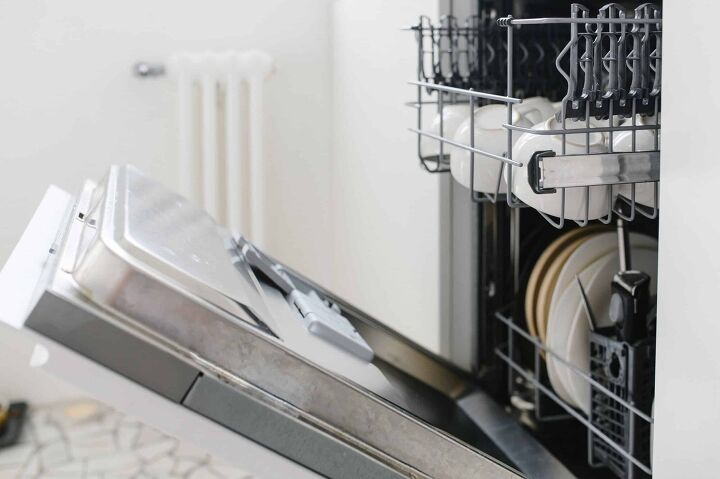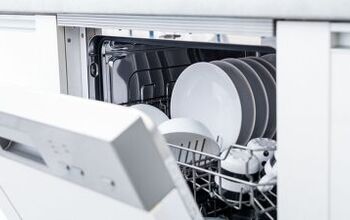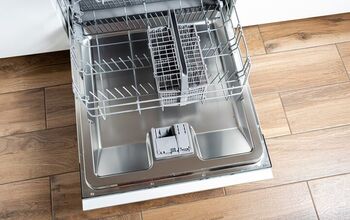Do I Need A Dishwasher Air Gap? (Find Out Now!)

Everybody’s least favorite part of a home-cooked meal is the cleanup. Doing the dishes can be a huge chore, but that’s where your dishwasher comes in! These miraculous machines can make quick work of big messes.
You need a dishwasher air gap to optimize your dishwasher’s performance. The air gap keeps wastewater from contaminating your clean dishwashing water. Additionally, it’s required per plumbing code to have a dishwasher air gap in most states and recommended in others.
Do You Need Appliance Repair Services?
Get free, zero-commitment quotes from pro contractors near you.

What Exactly Is an Air Gap?
An air gap is a small fitting that makes a space between a freshwater fixture and wastewater collection. Essentially, it’s a physical gap, such as between a faucet and the rim of a sink or tub basin.
Think of it this way. If a bathtub’s drain backed up, the tub would fill with wastewater, and spill over the top edge. However, the faucet would not be underwater because there’s a space between the faucet itself and the tub top.
It’s a similar concept to your dishwasher. Air gaps physically separate the pipes that run clean water and wastewater. If the two never physically meet, they don’t have a chance to contaminate each other.
The air gap prevents wastewater from backing up into a freshwater supply. In the example above, it prevents wastewater from getting into the faucet and contaminating the clean water source. The same principle applies to a dishwasher.
When wastewater gets into a freshwater supply by retracing the steps of freshwater, this is called backflow. There are several methods of preventing backflow, but air gaps have proven to be the most effective.
How Does an Air Gap Work?
An air gap works according to the principles of physics. It operates like a siphon, using gravity as its driving force.
In a siphon, there are two containers of liquids with a hose between them in an inverted u-shape. One container sits higher than the other. The liquid flows through the hose from the higher container to the lower container thanks to gravity.
In the air gap mechanism, the “lower container” is attached to the sink drain and/or garbage disposal. The wastewater can drain out with the help of gravity through a designated hose.
There are two branches of hose that pass through the air gap: one for wastewater and one for freshwater. This portion of the mechanism is usually hidden below a counter or sink. The header, however, must sit on the countertop to ensure it’s high enough for gravity to work its magic.
Sometimes it looks like both lines are housed within the same tube. Even if it looks that way from the outside, there’s a physical gap of air between them on the inside. This prevents any chance of cross-contamination between clean and dirty water.
What Does an Air Gap Look Like?
The Outside of a Dishwasher Air Gap
From the outside, you may not know that you’re looking at an essential dishwasher component. An air gap commonly has a small fixture that sits above the countertop, often near the sink faucet. It looks like a stub of a plumbing fixture, but it’s no accident or missing piece.
This header looks like a cylindrical plumbing fixture. It’s a couple of inches tall and must sit on top of the counter to function properly. Because of the physics involved, the high point of the air gap must be above the level of the dishwasher.
Some people find them unsightly, so they’ve come up with ways to camouflage them. There’s even a model of air gap that’s concealed in a soap dispenser!
The Inside of a Dishwasher Air Gap
If it’s hard to imagine what an air gap looks like on the inside; think of it this way.
Imagine you took a hose and folded it in half, creating a tight u-shape at the top, Then, imagine you snipped a chunk out of the hose that comes down the left side. The top is still curved up and over like a faucet from the pipe on the right.
If water were to flow up and over through this faucet, it would be deposited straight down into the hose on the left side. You’d be able to watch the water flow through the window you cut out. It’s as if the same line of pipe continues down the left side, but the “spout” is now disconnected.
Now imagine if water flowed up from the stub of pipe on the left side. It would overtop the pipe and spillover. However, it wouldn’t enter the upside-down u-shape or the right side of the pipe. This is exactly how an air gap works!
This process is replicated inside that header on a much smaller scale. If backflow occurs, water will spill out into the header itself, which has tiny holes in it. So if the header is leaking, you know you have a clog somewhere in the line that needs to be addressed.
Do I Really Need an Air Gap?
In many places, air gaps on dishwashers are required by plumbing code. A handful of states like Minnesota, Washington, and California require air gaps on all-new dishwasher installations in residential homes. Commercial kitchen prep sinks used in food and beverage production almost universally require air gaps.
International Residential Code, which sets building standards across industries, includes plumbing specifications for air gaps. It states that the air gap must be two times the inner diameter of the pipe in order to meet the requirements.
Air gaps are important for reasons beyond your safety and peace of mind in the kitchen. It’s important to make sure your home is up to current building codes. When you sell a house, for instance, inspectors will make sure little things like this are up to date.
Of course, most of these codes regulate the installation of new appliances. If your existing dishwasher doesn’t have an air gap, it’s your choice if you’d like to install one. Otherwise, you can wait until you upgrade your kitchen appliances.
Can an Air Gap Go Bad?
Since air gaps work on the principles of physics, there are no moving parts that can break. Gravity is always consistent, unless you’re using a dishwasher in outer space. Air gaps are effective in most circumstances, even when other devices might fail.
Do You Need Appliance Repair Services?
Get free, zero-commitment quotes from pro contractors near you.

Related Questions
What is a dual inlet air gap?
A dual inlet air gap allows two dishwashers to connect with one drain line. It can also be used to connect another appliance, like a water filter, to the air gap and drain.A built-in countertop reverse osmosis water filter is a good example. Reverse osmosis wastewater, known as brine, needs to be processed the same way as dishwasher wastewater. By using a dual inlet air gap, the tangle of pipes needed to connect the drains can be simpler.
What is a high loop?
A high loop is another alternative to an air gap that helps to prevent backflow. Some people think a high loop is a sufficient solution, while others say it’s not an adequate replacement for an air gap.This device functions based on all the same principles of an air gap: physics, gravity, and the siphon. The pipe that runs from high to low in this case is continuous, and not separated like an air gap.Because it operates in largely the same way, a high loop will work to keep wastewater separate from freshwater most of the time. In situations of extreme backflow, however, contamination can occur.A high loop is not as foolproof as an air gap. For this reason, many people (and building codes) prefer to install an air gap when available. It satisfies some plumbing codes and is better than nothing, but it’s always better to be safe than sorry!
Do I need a dishwasher air gap with a garbage disposal?
Yes, an air gap is still recommended with a garbage disposal. If your sink clogs and you activate the garbage disposal to clear it, backflow can still enter the dishwasher. Better safe than sorry!
Bridging The Gap
Basically, air gaps are a must-have when installing a new dishwasher. The building codes of many localities require them, and it’s a good practice to have one even if not required.
If you have an existing dishwasher with a high loop, you’re probably in good shape. Keep an eye out for any lingering food debris in your dishwasher, and clean out the wastewater pipe as needed.
Of course, you can avoid clogs that lead to backflow by performing regular maintenance on your dishwasher. Keeping the dishwasher clean will help you keep dishes clean, even after the messiest of dinner parties. Bon appetit!

Stacy Randall is a wife, mother, and freelance writer from NOLA that has always had a love for DIY projects, home organization, and making spaces beautiful. Together with her husband, she has been spending the last several years lovingly renovating her grandparent's former home, making it their own and learning a lot about life along the way.
More by Stacy Randall



























